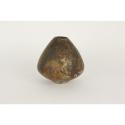Vase
Classification(s):
Pottery
Date: c. 1951-1976
Maker: Ruth Duckworth (1919 - 2009)
Dimensions:
205 × 230 mm (20.5 × 23 cm)
Medium: Stoneware
Object number: P91A
See Also
DescriptionStoneware textured vase by Ruth Duckworth. The vase has a small foot; the body broadens outwards and tapers towards the mouth. Retailed for £4.20.
Potters stamp “RWD” to base.
Label to front “P91A £4.20 Ruth Duckworth”.
Potters stamp “RWD” to base.
Label to front “P91A £4.20 Ruth Duckworth”.
ProvenanceThis object was originally acquired for the Inner London Education Authority’s (ILEA) ‘Circulating Design Scheme’ collection.
The collection was instigated by the London Country Council (later the Greater London Council) and the Council of Industrial Design (COID). The collection’s original purpose was concerned with the teaching and dissemination of modern, ‘good design’.
The collection was established in 1951/52 as the ‘Experiment in Design Appreciation’, later renamed the ‘Circulating Design Scheme’.
The Circulating Design Scheme lent boxed showcases to London schools. The showcases contained handling objects, material samples and interpretation on a specific subject.
COID withdrew its involvement in the Scheme in 1957. After which time, it was managed exclusively by the London County Council from 1957-1963.
After the administrative restructuring of London authorities, the Scheme was jointly managed by the Greater London Council and the Inner London Education Authority (ILEA) from 1963 – 1976.
The Scheme was operational until 1976 when the collections were withdrawn from circulation. ILEA was abolished in the late 1980s and the collection was donated to Camberwell College of Arts in 1989/90.
ILEA was responsible for secondary and tertiary education in the inner London boroughs, this included Camberwell.
The collection was instigated by the London Country Council (later the Greater London Council) and the Council of Industrial Design (COID). The collection’s original purpose was concerned with the teaching and dissemination of modern, ‘good design’.
The collection was established in 1951/52 as the ‘Experiment in Design Appreciation’, later renamed the ‘Circulating Design Scheme’.
The Circulating Design Scheme lent boxed showcases to London schools. The showcases contained handling objects, material samples and interpretation on a specific subject.
COID withdrew its involvement in the Scheme in 1957. After which time, it was managed exclusively by the London County Council from 1957-1963.
After the administrative restructuring of London authorities, the Scheme was jointly managed by the Greater London Council and the Inner London Education Authority (ILEA) from 1963 – 1976.
The Scheme was operational until 1976 when the collections were withdrawn from circulation. ILEA was abolished in the late 1980s and the collection was donated to Camberwell College of Arts in 1989/90.
ILEA was responsible for secondary and tertiary education in the inner London boroughs, this included Camberwell.
NotesRuth Duckworth came to the UK in 1936, fleeing the Nazi regime. She began studying pottery at Hammersmith Art School following the advice of fellow émigré potter Lucie Rie. Duckworth later studied at the more experimental Central School of Arts and Crafts. Duckworth approached clay as a sculptor as opposed to a potter; she produced vessel forms and figurative sculptures that were hand-built or coiled and often asymmetrical. Her work often derived from abstracted forms in nature.







